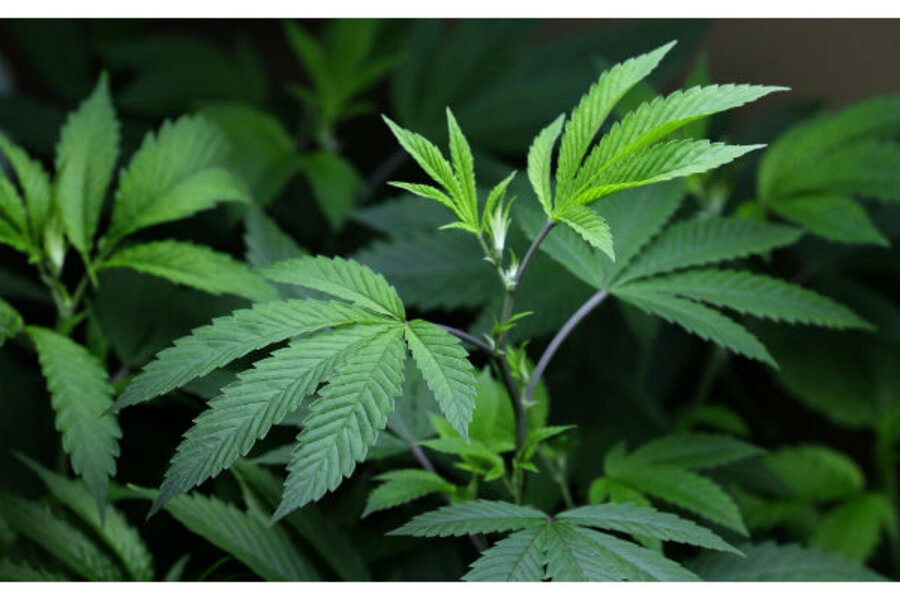Teen marijuana use rises as risk perception wanes
Loading...
State-level campaigns to legalize marijuana for medicinal and recreational purposes may have led to a dramatic drop in the percentage of teenagers who see great risk in regular use of the drug, the researchers of an annual nationwide drug-use survey said Wednesday.
With the perceived decrease in risk came a parallel increase in teen use of marijuana, they said, which is particularly troubling because the drug blocks brain functioning that is crucial to mental development, learning, and memory in adolescents.
Meanwhile, teens' use of other drugs, such as alcohol and cigarettes, continued to decline, according to the National Institutes of Health's 2013 Monitoring the Future Survey, which adds context to its findings with anonymous, written answers from 41,765 8th, 10th, and 12th graders at 389 public and private schools around the country.
This year, 39.5 percent of 12th grade respondents said they view regular marijuana use as harmful, down from 44.1 percent last year and rates of between 70 and 80 percent in the early 1990s, the survey shows.
At the same time, 6.5 percent of surveyed seniors reported daily marijuana use this year, compared with 6 percent in 2003 and 2.4 percent in 1993, researchers said. Nearly 23 percent of surveyed seniors reported use of marijuana in the month prior to the survey, and about 36 percent said they had smoked it in the last year.
Among 10th grade respondents, 4 percent reported daily marijuana use, 18 percent said they'd used it in the past month, and 29.8 percent said they'd used it in the last year. And more than 12 percent of 8th grade respondents said they'd used marijuana in the year preceding the survey.
And states with medicinal marijuana laws are providing venues for increased use, despite regulatory controls that were promised to voters when those laws were approved, said Gil Kerlikowske, Director of National Drug Control Policy at the White House. Of marijuana-using 12th graders living in states with medical marijuana laws, 34 percent reported obtaining the drug through someone else's prescription, and 6 percent said they have prescriptions of their own, the survey says.
Kerlikowske said in a conference call with reporters this morning that the assertion by some supporters of legalizing marijuana that the drug is not as dangerous as other substances is "a ridiculous statement," and that marijuana use is particularly troubling in teenagers.
"Their brains are still developing," Kerlikowske said. "And conditions for their success later in life are being cast in these important, formative years."
Dr. Nora Volkow, director of the National Institute of Drug Abuse, said research has showed that marijuana use in the teen years blocks receptors that allow communication between different sectors of the brain, particularly the hippocampus, which regulates memory. That can inhibit a teen's ability to learn and develop, she said.
Speaking about drug use in general, Kerlikowske said more schools need to offer consistent, age-sensitive drug education over a multi-year period instead of warning about the risks of drug use in an isolated unit worked into a health or physical education class.
The study did have some bright points, researchers said.
For the first time in the survey's history, the percentage of students in all three grades combined who said they smoked tobacco cigarettes in the past month is below 10 percent (9.6 percent), compared with 16.7 percent 10 years ago and 24.7 percent in 1993. Daily smoking of cigarettes was at 8.5 percent for surveyed seniors, 4.4 percent for 10th graders, and 1.8 percent for 8th graders.
The use of alcohol by teens also continued its steady decline. For surveyed 12th graders, alcohol use peaked in 1997, with more than half (52.7 percent) reporting drinking alcohol in the month before the survey. Only 39.2 percent of seniors reported past-month use this year. An indicator of binge drinking (defined in the survey as five or more drinks in a row at least once in the past two weeks) stayed the same as last year for 8th graders (5.1 percent) but dropped considerably for 10th graders (to 13.7 percent from 15.6 percent in 2012.) The 2013 binge drinking rate for 12th graders is 22.1 percent.
The survey also showed drops in abuse rates for Ritalin, Vicodin, prescription cough syrups, and synthetic marijuana products. Use of inhalants, substances known as "bath salts," and herbal salvia also declined, while rates of use of cocaine and heroin remained relatively unchanged, the survey showed.
Complete survey results and interviews with researchers are available online.
Editorial Projects in Education holds all rights to this article.
States Grapple with Common Test-Score Cutoffs
NAEP Gains in D.C., Los Angeles Outpace Other Big Cities
Tech. Compatibility Certification Set Up for Common-Core Testing





